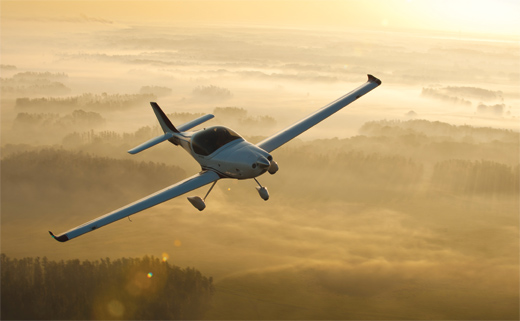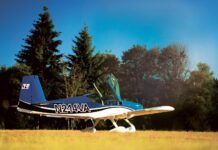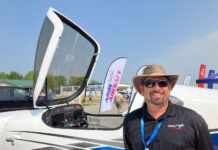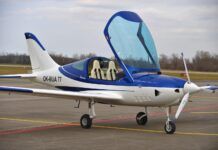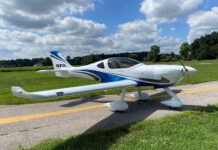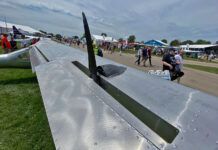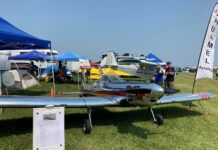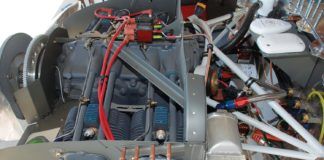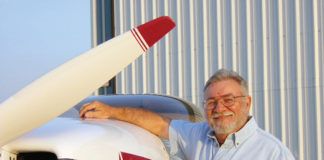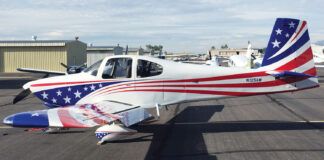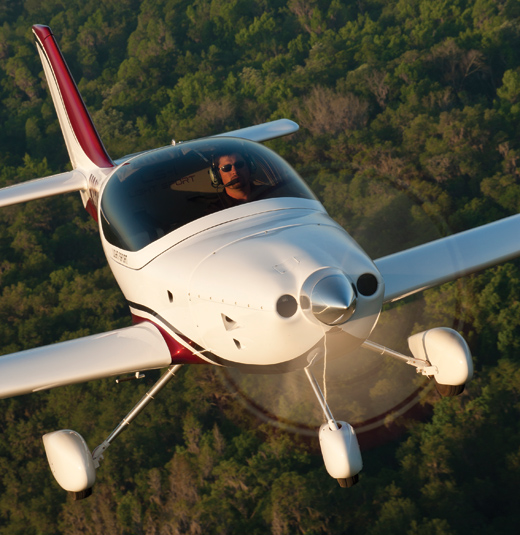 You don’t get a second chance to make a first impression, or so the familiar phrase goes. That may be true on the face of it, but where light aircraft are concerned, a long-term development program can often take flawed designs—whether those flaws are large or small—and make them significantly better over time. There are many examples of kitbuilt aircraft that have improved tremendously from the first prototype, making that first impression accurate for the instant that it happened but not representative of what’s on the market today.
You don’t get a second chance to make a first impression, or so the familiar phrase goes. That may be true on the face of it, but where light aircraft are concerned, a long-term development program can often take flawed designs—whether those flaws are large or small—and make them significantly better over time. There are many examples of kitbuilt aircraft that have improved tremendously from the first prototype, making that first impression accurate for the instant that it happened but not representative of what’s on the market today.
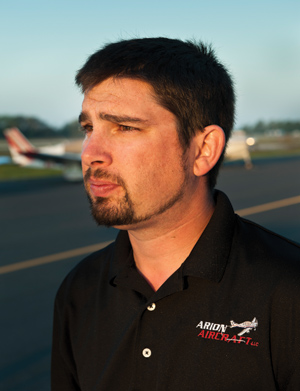
Add to that list of improved aircraft the Arion Lightning. In fact, you could say a big update has struck twice with the low-wing Light Sport Aircraft. (It’s sold as both an Experimental/Amateur-Built aircraft and a ready-to-fly Special LSA.) The last time we covered the Lightning was Chuck Berthe’s flight review for the September 2008 issue. Prior to that story’s publication, Berthe flew two different Lightning factory ships, the first and second prototypes.
In the first prototype, Berthe noted the Lightning’s very light stick forces and low longitudinal stability. That early prototype had a number of characteristics no longer found in the design, including a spring bungee system, heavier tail surfaces and a shorter engine mount. Between Berthe’s two flights, Lightning designer Nick Otterback revised the airplane, in part based on Berthe’s comments. Those alterations included an engine mount 1 inch longer than before—moving the entire mass of the engine that much farther forward—as well as a separate trimtab on the elevator, revised stick/elevator gearing and a subtle repositioning of heavy airframe components, with an eye toward moving the ship’s empty weight forward. Berthe thought that the original design might be running too close to its aft-CG limit with a normal load—a limit, he felt, that should have been moved forward. In fact, Otterback did specify a new, more forward limit for customer airplanes.
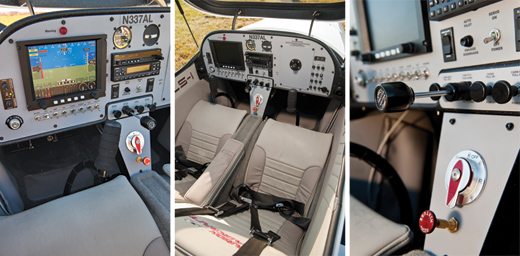
Berthe’s second impressions were much more positive. While the airplane still had light control forces, with a stick force per G of 4 pounds, it now displayed positive longitudinal stability in all phases of flight. At the time, we roundly praised Otterback for listening to an outside test pilot and making what we felt were important improvements to his design. Even though the U.S. economy as a whole was pitiably weak in this period, the Lightning kits and SLSAs sold well enough for Otterback and his dozen employees in Shelbyville, Tennessee, to keep the lights on and even commit more time to product improvement.
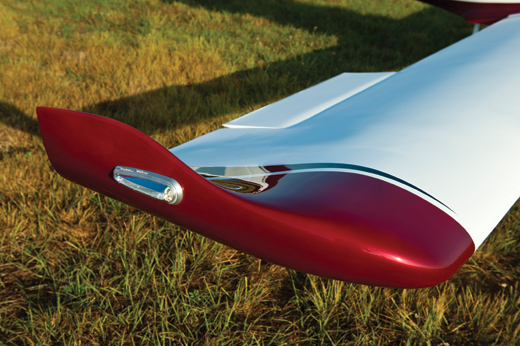
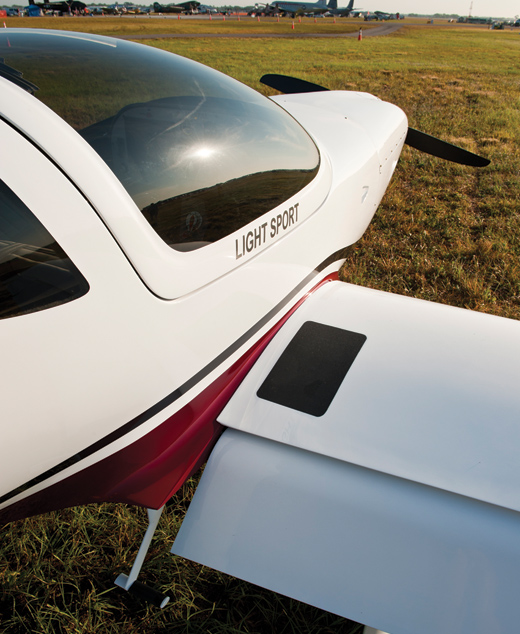
Four Years On
I ran into Otterback at the Sebring show this January, where he hinted that additional updates were nearly ready for the Lightning. “You remember all the discussion of stability,” he said. “Well, even though I kept working at the issue, I was never 100% happy with the results. Yeah, we improved it, but I thought it could be better still. So now we have what I think is the final fix: a new tail.”
In truth, the updated Lightning carries over most of the major structural components, but the horizontal tail has more area: 3 square feet, to be exact. “It doesn’t sound like a lot,” Otterback said, “but it’s very effective in increasing stability. We felt that this stability would be great for the pilots coming out of standard GA planes.” In theory, a horizontal stabilizer with more volume makes the airplane more trim stable. When disrupted from the trimmed condition, the stabilizing force will be larger, all else being equal, so the airplane will tend to return to its trimmed airspeed more quickly. Such a change also means the airplane will resist maneuvering inputs, and the trick is to balance this newfound stability with good overall control balance and intuitive responses. You don’t want, in the course of adding stability, to turn this lithe little airplane into a fiberglass pickup truck.
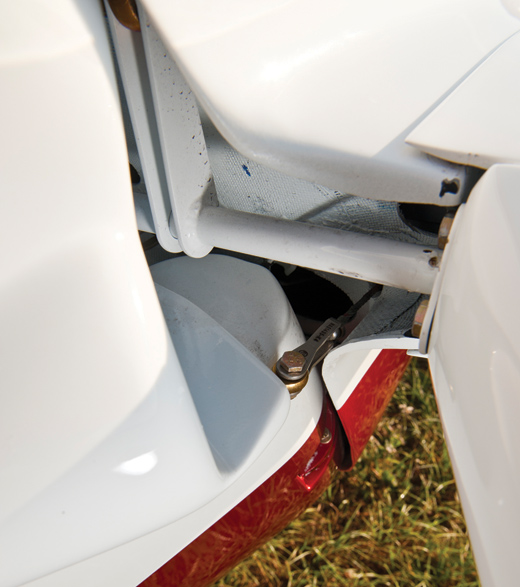
There are other changes to the tail group. “The smaller tail needed an up-spring on the elevator to help with trim authority, but we’ve removed that spring with this tail,” Otterback said. Regular readers of this magazine might recall that Berthe noted that the second prototype he flew in 2008 did not have enough up-trim to fly hands-off down the final approach. And while the elevator and trimtabs have the same area as before, the maximum up-throw on the elevator has been decreased from 25 to 15.
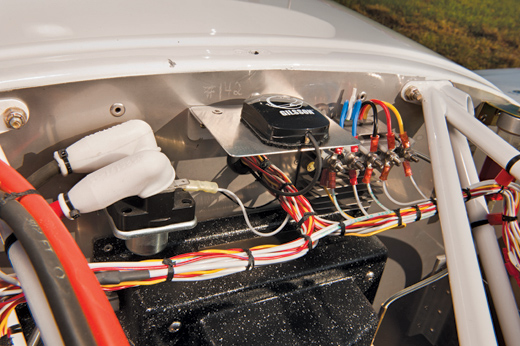
Finally, Otterback was contemplating some additional changes to the control gearing. Berthe felt that the stick/flight surface leverage ratios were too great, making the stick forces too low. During my visit to the factory, Otterback hadn’t decided if the new system needed a similar change in gearing to improve control balance. (Subsequently, he decided to reduce stick leverage and wrote to say, “Wow. It’s really nice now. The stick movement is shortened by about 1 inch at the limits. The pitch now is right on breakout force with the roll, and when making pitch changes without re-trimming, the plane really talks back.”)
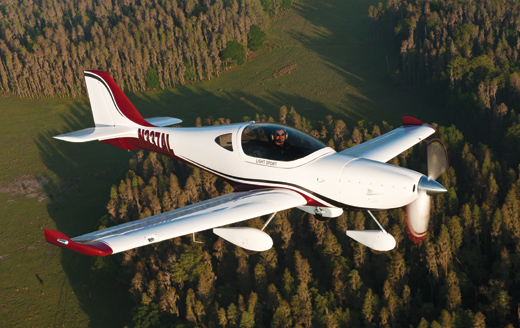
Both airplanes I flew were LSA-compliant designs, limited to 1320 pounds maximum gross weight and with wingtip extensions that add 12 square feet of wing a side and extend total span from 27.2 to 30.5 feet. The non-LSA version of the Experimental/Amateur-Built Lightning can go to 1425 pounds and will, according to the company, cruise at 135 to 140 knots. With standard fuel capacity of 22 gallons, an LSA variant can carry approximately 370 pounds. On the other end, a non-LSA version, with the optional long-range tanks (30 gallons), can carry about 410 pounds.
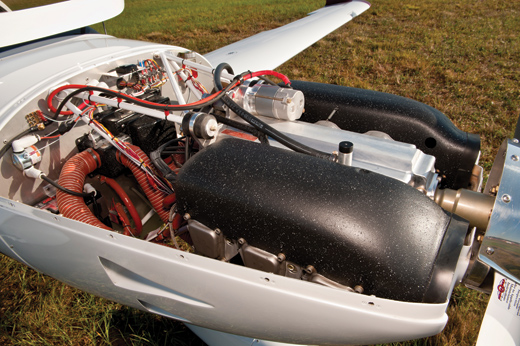
Meet the Lightning
In case you’re unfamiliar with the Lightning, sit tight for a little history. The design was penned by Otterback and Pete and Ben Krotje, who are also partners in the Jabiru USA side of the business. Arion Aircraft and Jabiru USA share two side-by-side hangars at the Shelbyville airport. (If you’re there for a visit, know that the town is pronounced shovable. Don’t forget.) The facility handles importation and repair of Jabiru engines, research and development, complete assembly of SLSA models (Jabiru and Lightning), kit mustering and customer assistance for both airplane lines.
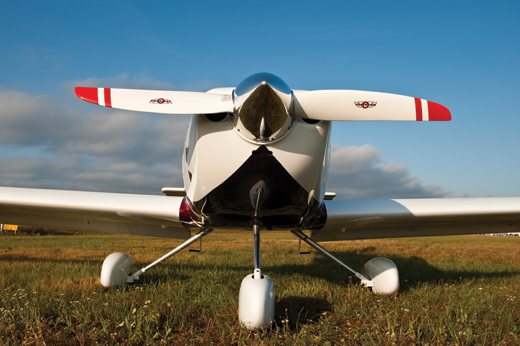
Some have suggested the Lightning is a 3D scan of the Swedish Esqual, but that’s not the case. It’s true that Otterback used an Esqual fuselage to prove the Lightning’s wing design, but beyond that the Lightning is its own deal. In many respects, the Lightning follows classic composite low-wing design philosophies with a large fuselage shell, split vertically, that extends from the firewall to the top of the vertical stabilizer. The wingroot fairings are integral with the fuselage shell, a detail that gave this Pulsar builder the warm glow of recognition, quickly followed by a phantom fiberglass itch.
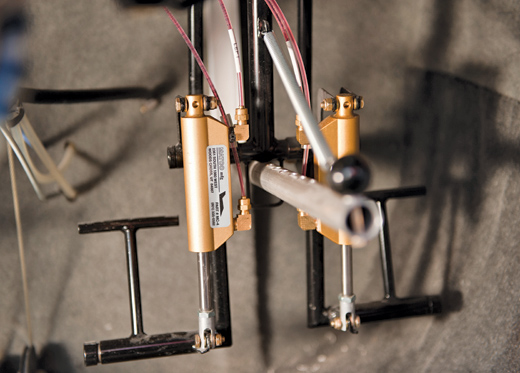
Where the Lightning departs from convention is its use of a welded-steel structure in the belly that ties landing gear legs and spar attach points together. This pre-built (and powder-coated) structure defines a few really important dimensions and structural relationships for the builder, ensuring accuracy in the final product. Moreover, this structure contains the main control sticks and pickup points for the pitch and roll systems. It’s pushrods and torque tubes for the elevator and ailerons, cables for the rudder, and a torque tube actuating the flaps via an electric jackscrew, also installed in this carry-through structure. Finally, this beefy weldment provides a lower support for the instrument panel and offers pickup points for the inboard seat belts. It sounds complicated, but by creating this literal framework for the builder, Arion has dramatically reduced the amount of time spent creating raw structure and fiddling with mounting brackets for all these components.
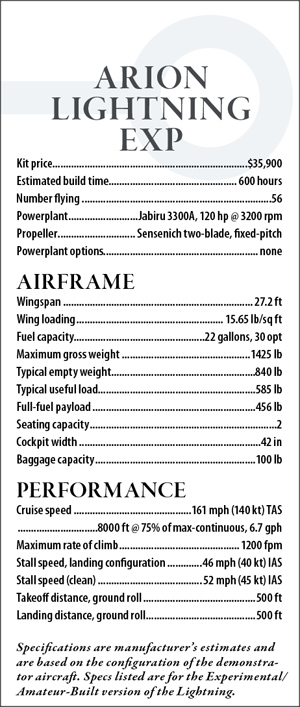
What’s That Smell?
Otterback revealed another significant change to the Lightning, something I thought I detected out in the shop by smell. Where the Lightning had used an epoxy-based system, it’s now using a modern vinylester resin. The epoxy/vinylester disputes go back to the Glasair/Lancair days, with each touting the benefits of the chosen method. But Otterback made the jump for good reasons. “Vinylester is very strong and light in this case,” he said. “We’ve been working with our composites shop on this change, and so far we’re very happy with it.” That shop is Fiberglass Molding in Weyauwega, Wisconsin (say that 10 times fast). Vinylester has a few operational advantages over epoxy, mainly in that its cure time can be varied by the amount of catalyst, where epoxy must be mixed in the exact specified ratio to maintain its strength. Customers working in warm climates tend to fight with epoxy’s short cure time on large layups.
How’d They Do?
Otterback and I had a full day for flying just after Sun ‘n Fun this year to test the big-tail Lightning and, fortuitously, had access to a recently built original Lightning for back-to-back comparisons. On the taxi out, Otterback briefed me on the Lightning. “You’ve probably flown a lot of different airplanes, but the one you should think back to is your Pulsar,” he said. “I like to fly with my forearm on my leg and just a couple fingers around the stick. Even with the new tail, you won’t need to use a lot of force to fly it.”
Runup is typical Jabiru. All Lightnings fly with the 120-horsepower, six-cylinder Jabiru 3300—in fact, because that’s the only choice (unless you want to totally engineer a firewall-forward installation). The company provides everything in the FWF kit, including mounts, oil cooler, lines, cables…the works. It’s carbureted with twin ignition systems, so the runup more resembles that of a Cessna 172 than the high-performance airplane the Lightning appears to be. With both ignition systems working and a small drop from the application of carb heat, we were ready to go. Flaps go to half—total travel is 25—for takeoff, verified by an indicator on the GRT Avionics EFIS.
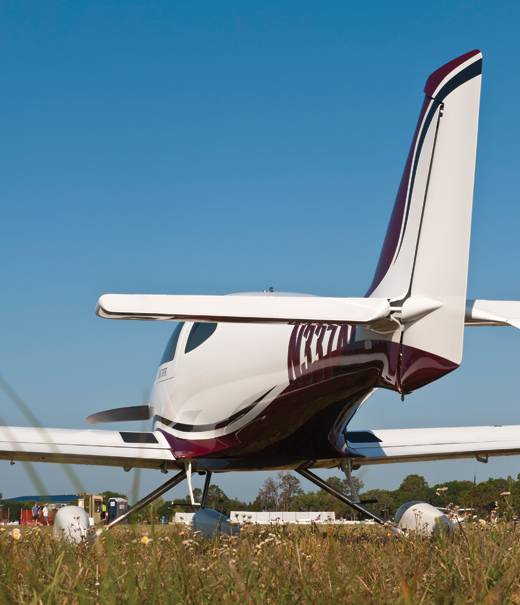
Power applied, the Lightning accelerates well. Otterback likes to raise the nose early in the takeoff run and let the airplane fly off, as opposed to using a more deliberate unstick motion. Within 8 seconds, the Lightning had accelerated to 55 knots indicated (KIAS) and had become light on the mains. Immediately after, it flew off on its own. Placing the end of the long nose right on the horizon resulted in a slightly flat climb angle as the airplane accelerated through 60 and then 70 KIAS. Initial rate of climb was 1000 fpm with two on board and three-quarters fuel. In this high-power, low-speed configuration, the Lightning needed little right rudder to maintain coordinated flight and showed good stability. It seemed natural to allow the airspeed to creep up to 80 to 85 KIAS, which gave 700 to 900 fpm in the climb through 2000 feet MSL.
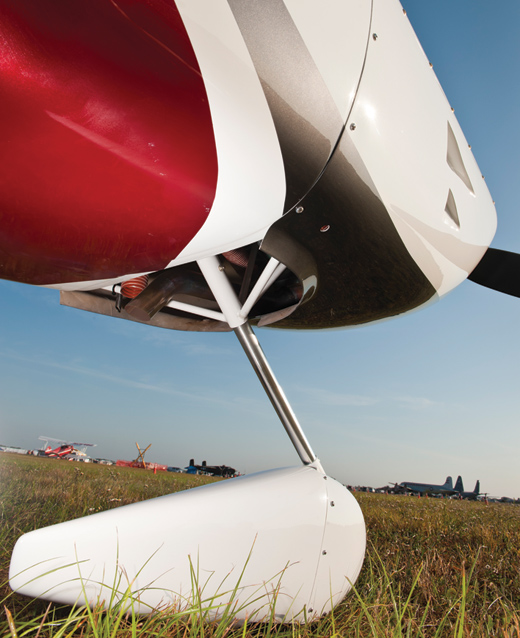
Cruise checks at 5000 feet MSL (a density altitude of 6095 feet on this day) revealed good performance. This Lightning was running the Sensenich 60×57 two-blade composite prop, the recommended setup for the LSA version. (The Experimental/Amateur-Built version of the Lightning can be built to conform to LSA rules, but if you choose to build it to a higher gross weight and allow a higher cruise speed, Arion recommends the Sensenich 62×58 scimitar-style FK-blade prop.) Set to 2850 rpm, the Jabiru pulled this Lightning up to 117 knots true airspeed on 5.3 gph, according to the GRT engine monitor. A two-way GPS run gave us an average of 118 knots. Otterback says the Lightning will gain a few knots at optimum altitude. Pulled back to 2600 rpm, the airplane does 100 KTAS on 3.9 gph.
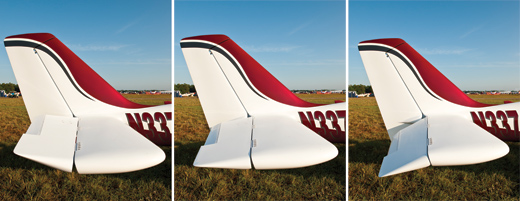
Manners, Improved
Otterback and I tried a simple series of stalls, clean and dirty, which showed that the Lightning has very good trim tenacity. He pointed out during our flight that the small-tail airplane needs little adjustment of the pitch with a fairly wide range of speeds; the current airplane definitely called for blips of the electric trim motor to zero stick forces. Stalls dirty give a mild burble with the airspeed needle stuck on 40 knots and no tendency to drop a wing, and recovery is a mere relaxation of back pressure away. So far, so good.
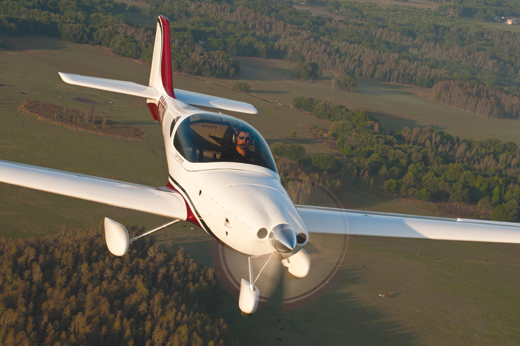
An important test for longitudinal stability is to displace the airplane in pitch and see how it reacts. A strongly stable airplane will immediately move the nose in the recovery direction (down, if the pitch input is up), gently pass through the trimmed airspeed and eventually work toward that trim equilibrium. The modified Lightning did just that. Trimmed for 100 KIAS and displaced nose-up by 10, the airplane responded promptly with a nose-down correction, a shallow dive through the trimmed pitch attitude and a complete recovery in just more than one cycle. I wouldn’t call the response snappy, as you’d find in a certified airplane, but absolutely acceptable.
(To gain some perspective, Otterback and I took the small-tail Lightning aloft later that afternoon. In the same tests, the airplane would hold the nose above the horizon and gently, over the course of 30 to 50 seconds, begin recovery. In a nose-down pulse, the nose would stay down, and even though the airplane gained speed fairly rapidly, the nose barely started to rise.)
Inbound to Shovable
Initial approach speed for new pilots and visiting journalists is 60 KIAS, which provides a ton of extra energy in the roundout. The flaps are effective with a mild nose-down pitch change on deployment. In general, the approach feels a bit flat and the pitch window appears narrow, but that’s mainly an optical illusion. Starting from 60 knots, the trick is to manage the deceleration in ground effect, which is made easy by the strong rudder and excellent aileron effectiveness. In fact, the airplane is as nicely balanced at these low speeds as it is in cruise, with roughly equal pitch and roll forces, and higher yaw forces, as you’d want. Otterback was considering, again, adjusting the elevator gearing with the new tail, and it’s likely that reducing the stick’s mechanical advantage on the elevator will result in slightly higher pitch forces, which in turn would bring the airplane toward the more desirable control harmony—with roll lighter than pitch lighter than yaw.
Nevertheless, I found no difficulty in the landings, and in looking at the video of the flights, it’s painfully clear that my control-stick movements were much less numerous in the large-tail airplane than in later flights in the other Lightning. (Amazing how much you don’t recall about a flight that’s right there in the video.) Even on this relatively calm day, it was clear that the pilot’s workload will be lower with the improved stability. Later landings, with 55 KIAS as the initial speed, were better, with a more positive payoff at the end and the ability to put the airplane down at any chosen point.
Very Nice Just Got Better
After this unusual opportunity to fly both Lightnings, it’s gratifying to see how much improved the new airplane is. Otterback has once again made the effort to improve his airplane and it’s paid off handsomely. Despite a high level of factory completion—the control surfaces are completed and closed, fuel tanks finished, fuselage seamed together and fitted with structural bulkheads—the Lightning kit is reasonably priced at $35,900. That’s before you add the engine, avionics, prop, paint and interior, of course, but considering the amount of work done for the builder and the high quality of the components I saw, that’s a pretty good deal. That the airplane continues to improve, becoming more accessible to pilots coming directly from certified aircraft, makes it even more impressive. Maybe the best first impression is actually the third time’s charm.
For more information, call 931-680-1781 or visit www.flylightning.net.
